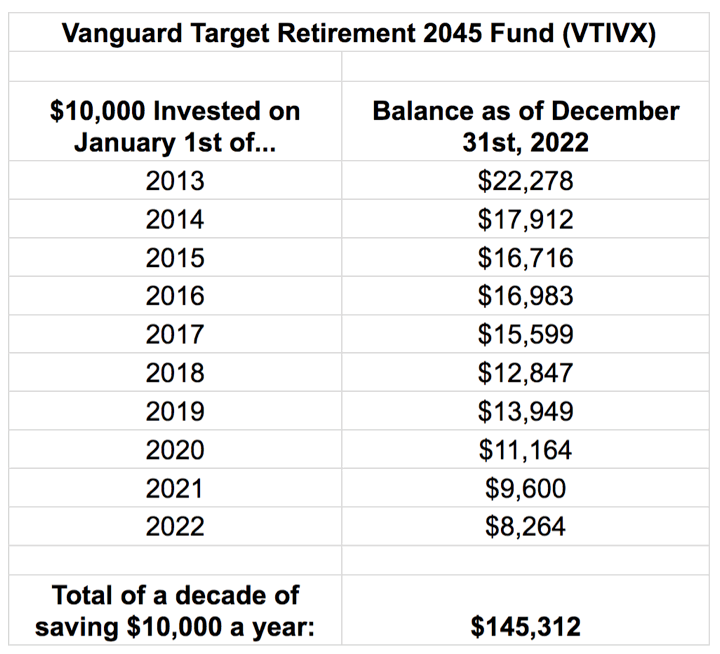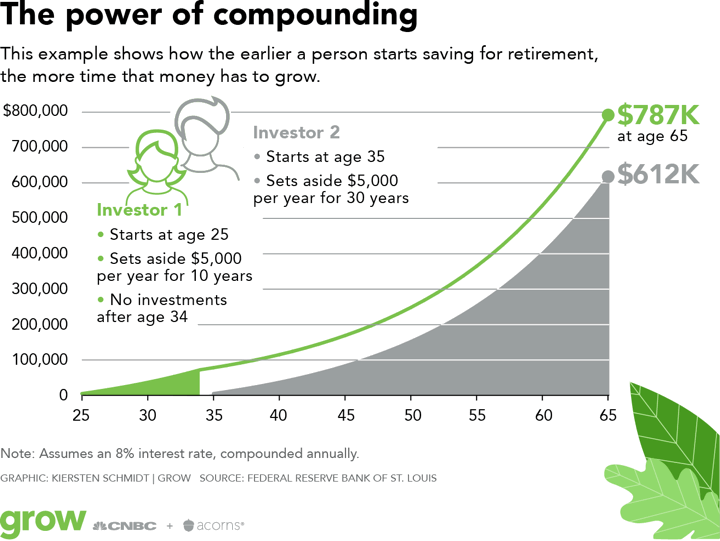
Instead of only looking at year-to-date or last year’s return numbers that are often quoted in the media, I also like to take a longer-term perspective (especially on down years). How would a steady investor have done over the last decade?
Target date funds. The is an all-in-one fund that is low-cost, globally-diversified, and available both inside many employer retirement plans and to anyone that funds an IRA. When you are young (up until age 40 for those retiring at 65), this fund holds 90% stocks and 10% bonds. It is a solid default choice in a world of mediocre, overpriced options. This is also a good benchmark for others that use low-cost index funds.
The power of consistent, tax-advantaged investing. For the last decade, the maximum allowable annual contribution to a Traditional or Roth IRA has been roughly $5,000 per person. The maximum allowable annual contribution for a 401k, 403b, or TSP plan has been over $10,000 per person. If you have a household income of $67,000, then $10,000 is right at the 15% savings rate mark. Therefore, I’m going to use $10,000 as a benchmark amount. This round number also makes it easy to multiply the results as needed to match your own situation. Save $5,000 a year? Halve the result. Save $20,000 a year? Double the numbers, and so on.
The real-world payoff from a decade of saving $833 a month. What would have happened if you put $10,000 a year into the Vanguard Target Retirement 2045 Fund, every year, for the past 10 years? With the interactive tools at and a Google spreadsheet, we get this:

Investing $10,000 every year ($833 a month, or $384 per bi-weekly paycheck) for the last decade would have resulted in a total balance of $145,000. That’s $100,000 in steady contributions and $45,000 in investment gains.
It gets even better over time. There is a popular example of the power of compound interest that shows how someone who started saving at age 25, saves and invests for 10 years but then stops and never saves a penny again still beats someone who starts saving at 35 and keeps on saving for 30 years. provides a nice illustration:

The “Rule of 72” shows us that with just 7.2% annual returns, your money will double every decade from now on. After another 10 years, every $100k will be $200k. After another 10 years, that $200k will be $400k. Once you have that initial momentum, it just keeps going.
Here are my previous “saving for a decade” posts:
- (January 2012 to December 2021)
- (January 2011 to December 2020)
- (January 2010 to December 2019)
- (January 2009 to December 2018)
- (January 2008 to December 2017)
- (January 2007 to December 2016)
Bottom line. Saving now can be hard, especially when you see your investment balances drop. But over time, with consistency and starting early, things smooth out. You can truly build serious wealth with something as accessible and boring as an IRA/401k plan and a Vanguard Target Retirement fund (or a simple collection of low-cost index funds).
“The editorial content here is not provided by any of the companies mentioned, and has not been reviewed, approved or otherwise endorsed by any of these entities. Opinions expressed here are the author’s alone. This email may contain links through which we are compensated when you click on or are approved for offers.”
from .
Copyright © 2004-2022 MyMoneyBlog.com. All Rights Reserved. Do not re-syndicate without permission.